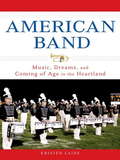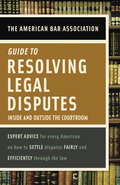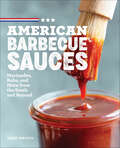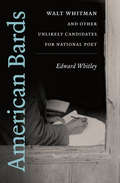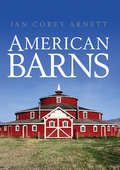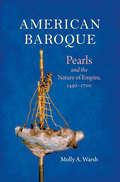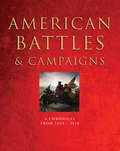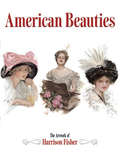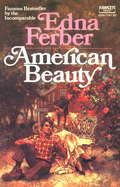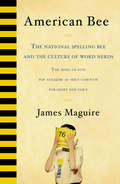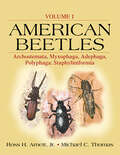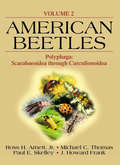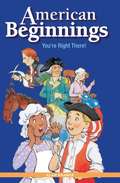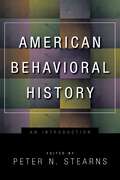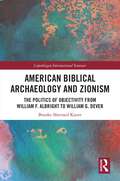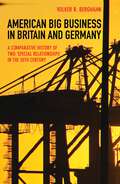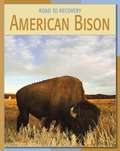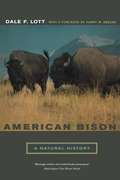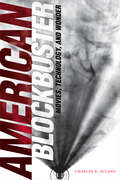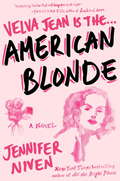- Table View
- List View
American Band
by Kristen LaineIn the spirit of Friday Night Lights comes the stirring story of a marching band from small-town middle America. Every fall, marching bands take to the field in a uniquely American ritual. For millions of kids, band is a rite of passage-a first foray into leadership and adult responsibility, and a chance to learn what it means to be a part of a community. Nowhere is band more serious than at Concord High School in Elkhart, Indiana, where the entire town is involved with the success of its defending state champion band, the Marching Minutemen. In the place where this tradition may have originated, in the city that became the band instrument capital of the world, band is a religion. But it's not the only religion-as legendary director Max Jones discovers when conflicting notions of faith and purpose collide during his final year as director. In this intimate chronicle, the band marches through a season that starts in hope and promise, progresses through uncertainty and disappointment, and ends, ultimately, in redemption.
American Bar Association Guide to Resolving Legal Disputes: Inside and Outside the Courtroom
by American Bar AssociationWhether you’re fighting with a neighbor about who should pay for a fence, pursuing a charge of discrimination at work, or chasing a $5000 loan, theABA Guide toResolving Legal Disputes: Inside and Outside the Courtroomcan help you decide what steps to take to resolve disputes. This book, written in easy-to-read language with dozens of real-life examples, includes tips on how to be a better negotiator. It also provides important information about mediation, arbitration, small claims court, and civil court procedures, and includes a chapter on working with a lawyer, with tips on how you can save time and money.
American Bar Association Guide to Wills and Estates, Fourth Edition
by American Bar AssociationThe American Bar Association Guide to Wills & Estates, Fourth Edition, is the user-friendly guide that contains everything you need to know about planning an estate and preparing a will. It is organized in easy-to-follow chapters with sidebars containing tips, checklists, and key information, encouraging you to begin the process quickly and easily.The ABA Guide to Wills & Estates will help you:* Determine what to put in an estate plan* Decide whether to prepare a will, trust, or living trust* Avoid or reduce estate taxes* Transfer property without a will with substitutes such as life insurance and joint tenancy* Understand the benefits of living gifts and life insurance, among many other topics The Fourth edition features new and updated topics, such as: * Life-threatening and chronic illnesses* Incorporating your religious beliefs into your estate plan * Assisted reproduction and its resulting estate planning implications* Civil unions and same-sex marriages* Elder abuse and care* Information about Roth IRAs in estate plans* The impact of digital assets on estate planning
American Barbecue Sauces: Marinades, Rubs, and More from the South and Beyond
by Greg MrvichKick up your cookout—barbecue sauces, marinades, and more from across the countryEvery barbecue master knows—the secret's in the sauce. American Barbecue Sauces is packed with savory recipes for bastes, glazes, mops, wet and dry rubs, marinades, condiments—and of course, sauces—from all over the United States. Fire up the grill!From Central Texas to Chicago, and Memphis to the Southwest and beyond, get to know America's barbecue belt with these explosively flavorful sauces and seasonings. Complete with classic favorites, creative concoctions, and a list of online resources that offer even more mouthwatering recipes, this book has everything you need to take your taste buds on a delicious road trip across the country.This saucy book includes:Barbecue basics—Discover details about American barbecue, including the big four BBQ regions, the five mother sauces, lesser-known BBQ styles, and more.Marinades, mops, and more—Explore other ways to heat up your barbecue game, with recipes like Cowboy Coffee Beef Rub, Basic Poultry Brine, and Old-Fashioned Glaze.Essential equipment—Convenient lists for stocking your kitchen include pantry items, necessary tools like basting brushes, and nice-to-haves like disposable gloves.Make your cookout really cook with tasty barbecue sauce recipes from the heart of America. Let's get cooking!
American Bards Walt Whitman and Other Unlikely Candidates for National Poet
by Edward WhitleyWalt Whitman has long been regarded as the quintessential American bard, the poet who best represents all that is distinctive about life in the United States. Whitman himself encouraged this view, but he was also quick to remind his readers that he was an unlikely candidate for the office of national poet, and that his working-class upbringing and radical take on human sexuality often put him at odds with American culture. While American literary history has tended to credit Whitman with having invented the persona of the national outsider as the national bard, Edward Whitley recovers three of Whitman's contemporaries who adopted similar personae: James M. Whitfield, an African American separatist and abolitionist; Eliza R. Snow, a Mormon pioneer and women's leader; and John Rollin Ridge, a Cherokee journalist and Native-rights advocate. These three poets not only provide a counterpoint to the Whitmanian persona of the outsider bard, but they also reframe the criteria by which generations of scholars have characterized Whitman as America's poet. This effort to resituate Whitman's place in American literary history provides an innovative perspective on the most familiar poet of the United States and the culture from which he emerged. Walt Whitman has long been regarded as the quintessential American bard, the poet who best represents all that is distinctive about life in the United States. Whitman himself encouraged this view, but he was also quick to remind his readers that he was an unlikely candidate for the office of national poet, and that his working-class upbringing and radical take on human sexuality often put him at odds with American culture. While American literary history has tended to credit Whitman with having invented the persona of the national outsider as the national bard, Edward Whitley recovers three of Whitman's contemporaries who adopted similar personae: James M. Whitfield, an African American separatist and abolitionist; Eliza R. Snow, a Mormon pioneer and women's leader; and John Rollin Ridge, a Cherokee journalist and Native-rights advocate. These three poets not only provide a counterpoint to the Whitmanian persona of the outsider bard, but they also reframe the criteria by which generations of scholars have characterized Whitman as America's poet. This effort to resituate Whitman's place in American literary history provides an innovative perspective on the most familiar poet of the United States and the culture from which he emerged.
American Barns
by Jan ArnettThe heart of every working farm and ranch, the barn is an icon of rural America. This book chronicles - and celebrates - all the main types, and looks at how these treasures of early American architecture developed. It explains how a wealth of immigrant construction methods and range of environments and climates resulted in a fascinating variety of barn styles in the United States, from the earliest rare Dutch examples to simpler English types and others in more surprising shapes (round or even polygonal) crafted by the Shakers in the 1800s. It highlights the most notable, famous and historic barns that the reader can visit, and features highlights the efforts of conservation groups to preserve America's barns and find innovative ways to repurpose these glorious old structures as homes and studios--and as living monuments of rural heritage.
American Baroque: Pearls and the Nature of Empire, 1492-1700 (Published by the Omohundro Institute of Early American History and Culture and the University of North Carolina Press)
by Molly A. WarshPearls have enthralled global consumers since antiquity, and the Spanish monarchs Ferdinand and Isabella explicitly charged Columbus with finding pearls, as well as gold and silver, when he sailed westward in 1492. American Baroque charts Spain's exploitation of Caribbean pearl fisheries to trace the genesis of its maritime empire. In the 1500s, licit and illicit trade in the jewel gave rise to global networks, connecting the Caribbean to the Indian Ocean to the pearl-producing regions of the Chesapeake and northern Europe.Pearls—a unique source of wealth because of their renewable, fungible, and portable nature—defied easy categorization. Their value was highly subjective and determined more by the individuals, free and enslaved, who produced, carried, traded, wore, and painted them than by imperial decrees and tax-related assessments. The irregular baroque pearl, often transformed by the imagination of a skilled artisan into a fantastical jewel, embodied this subjective appeal. Warsh blends environmental, social, and cultural history to construct microhistories of peoples' wide-ranging engagement with this deceptively simple jewel. Pearls facilitated imperial fantasy and personal ambition, adorned the wardrobes of monarchs and financed their wars, and played a crucial part in the survival strategies of diverse people of humble means. These stories, taken together, uncover early modern conceptions of wealth, from the hardscrabble shores of Caribbean islands to the lavish rooms of Mediterranean palaces.
American Barrick Resources Corp.: Managing Gold Price Risk
by Peter Tufano Jon D. SerbinManaging the risk of changing prices of gold is central to the business strategy of American Barrick Resources Corp., one of North America's largest and most successful gold-mining firms. The case contrasts this firm's hedging policies with those of its rivals that do not hedge and details the wide range of hedging products (gold loans, forwards, options, spot deferred contracts) used to manage price risk. In 1992 the management of American Barrick is pleasantly surprised by unexpected new gold finds, but this new production places demands on the firm's hedging program and tests the firm's commitment to hedging when prices of gold and of many hedging vehicles are unattractive.
American Battles & Campaigns: A Chronicle from 1622-2010
by Chris McNabRaids and sieges; trench warfare and air campaigns; guerrilla warfare, naval engagements, and colonial wars—American Battles & Campaigns covers every major campaign and battle fought in North America or by United States’ forces overseas, from the Pequot War of 1634 to the recent conflicts in Afghanistan and Iraq. Arranged chronologically, American Battles & Campaigns: A Chronicle, from 1622-Present includes hundreds of entries, ranging from the 1770 Boston Massacre through the Alamo (1836) and the Philippine-American War (1899–1902), to Chateau-Thierry (1918), Midway (1942) and Hue (1969). Major battles, such as Yorktown, Gettysburg, Pearl Harbor, and D-Day, are illustrated with full-color annotated 3-dimensional maps and detailed text explaining the course of the engagement. Stuffed with black and white and color photographs, battle maps, paintings and other artwork, American Battles & Campaigns contains expert accounts and analysis from thirty leading military historians.
American Beauties: The Artwork of Harrison Fisher
by Harrison FisherHarrison Fisher's portraits of healthy, poised, active, and confident women set the standard of American beauty in the early 20th century -- and he enjoyed a celebrity status that was unparalled for an illustrator. This original publication compiles his very best black-and-white and color illustrations for Cosmopolitan, The Saturday Evening Post, books, and other publications.
American Beauty
by Edna FerberOriginally published in 1931, this bestselling American family saga from Pulitzer Prize-winning author Edna Ferber shares the story of the Oakes family, as their relationships and property encounter numerous struggles over the course of hundreds of years.In the early 18th century, the Oakes family was one of many working to settle their land in the Connecticut Valley, facing harsh winters and land disputes. Their attempts over the years to tame the land and produce a properous tobacco farm prove more difficult than expected, and when the family takes on Polish immigrants to work the farm, cultures clash, and relationships become complicated. American Beauty follows the goings-on at the Oakes estate from 1700 through 1930, and whether in times of family turmoil or hopeful prosperity, Edna Ferber's cast of fascinating characters and pitch-perfect take on American life rings true.
American Bee: The National Spelling Bee and the Culture of Word Nerds
by James MaguireWhat the bestselling Word Freak did for Scrabble, this riveting narrative now does for the National Spelling Bee. Here is a captivating slice of Americana--part sporting event, part absorbing human drama, and part celebration of the magic of words. Every spring in the nation's capital, after a starting pool of 10 million kids narrows to 250 finalists, America's top young spellers face off in a nail-biting contest. So electric is the drama that millions of viewers tune in to watch ESPN's live telecastBut this national obsession is much more than a sporting story--and this first-ever narrative nonfiction book about the National Spelling Bee immerses the reader in unique subculture, portraying the endearing fraternity of brilliant, eccentric young word nerds who vie for a gold trophy, a hefty check, and a glorious moment of national fame.Author James Maguire, who like the contestants is an inveterate word nut, captures the agony and glory of this singularly American event. He profiles the top five spellers across the country, exploring their hopes and dreams-and strategies for winning--as they prepare for their moment in the spotlight. American Bee takes readers behind the scenes at the National Bee, providing a narrative thrill ride as the tension mounts round by round.
American Beetles, Volume I: Archostemata, Myxophaga, Adephaga, Polyphaga: Staphyliniformia
by Jr. Ross H. Arnett Michael C. ThomasA thorough update of Arnett's The Beetles of the United States, American Beetles, Volumes I and II cover the genera of beetles that occur in Alaska, Canada, and the contiguous United States. Built on the foundation of the original work and almost completely rewritten with contributions from more than 60 coleopterists, these volumes describe each fa
American Beetles, Volume II: Polyphaga: Scarabaeoidea through Curculionoidea
by J. Howard Frank Ross H. Arnett Michael C. Thomas Paul E. SkelleyExperts offer the most sweeping reference available on the subject of North American beetles. Their rigorous standards for the presentation of data create a concise, useful format that is consistent throughout the book. This is the resource of choice for quick, accurate, and easily accessible information.
American Beginnings You're Right There!
by Alison Adams Alan Kramer Richard KoldingFind out about the amazing people and key events that led to American Independence.
American Behavioral History: An Introduction
by Peter N. StearnsFrom his founding of The Journal of Social History to his groundbreaking work on the history of emotions, weight, and parenting, Peter N. Stearns has pushed the boundaries of social history to new levels, presenting new insights into how people have lived and thought through the ages. Having established the history of emotions as a major subfield of social history, Stearns and his collaborators are poised to do the same thing with the study of human behavior. This is their manifesto. American Behavioral History deals with specific uses of historical data and analysis to illuminate American behavior patterns, ranging from car buying rituals to sexuality, and from funeral practices to contemporary grandparenting. The anthology illustrates the advantages and parameters of analyzing the ways in which people behave, and adds significantly to our social understanding while developing innovative methods for historical teaching and research. At its core, the collection demonstrates how the study of the past can be directly used to understand current behaviors in the United States. Throughout, contributors discuss not only specific behavioral patterns but, importantly, how to consider and interpret them as vital historical sources. Contributors include Gary Cross, Paula Fass, Linda Rosenzweig, Susan Matt, Steven M. Gelber, Peter N. Stearns, Suzanne Smith, Mark M. Smith, Kevin White.
American Betiya
by Anuradha D. RajurkarA luminous story of a young artist grappling with first love, family boundaries and the complications of a cross-cultural relationship. Perfect for fans of Sandhya Menon, Erika Sanchez and Jandy Nelson.Rani Kelkar has never lied to her parents, until she meets Oliver. The same qualities that draw her in--his tattoos, his charisma, his passion for art--make him her mother's worst nightmare.They begin dating in secret, but when Oliver's troubled home life unravels, he starts to ask more of Rani than she knows how to give, desperately trying to fit into her world, no matter how high the cost. When a twist of fate leads Rani from Evanston, Illinois to Pune, India for a summer, she has a reckoning with herself--and what's really brewing beneath the surface of her first love.Winner of SCBWI's Emerging Voices award, Anuradha D. Rajurkar takes an honest look at the ways cultures can clash in an interracial relationship. Braiding together themes of sexuality, artistic expression, and appropriation, she gives voice to a girl claiming ownership of her identity, one shattered stereotype at a time."A brave, beautiful exploration of identity--those thrust upon us, and those we forge for ourselves." --Elana K. Arnold, award-winning author of What Girls Are Made Of
American Biblical Archaeology and Zionism: The Politics of Objectivity from William F. Albright to William G. Dever
by Brooke Sherrard KnorrThis book examines the relationship between several of the most prominent American biblical archaeologists and Zionism. While these scholars have been studied and historicized to some extent, little work has been done to understand their role in the history of the Palestinian–Israeli conflict. Two defining differences in the archaeologists’ arguments were their understanding of culture and their views on objectivity versus relativism. Brooke Sherrard Knorr argues that relativist archaeologists envisioned the ancient world as replete with cultural change and opposed the establishment of a Jewish state, while those who believed in scholarly objectivity both envisioned the ancient world’s ethnic boundaries as rigid and favored Zionism. Combining readings of the archaeologists’ writings with archival research, this book studies the views of William Foxwell Albright, Millar Burrows, Nelson Glueck, George Ernest Wright, Paul Lapp, and William G. Dever regarding the establishment of an ethno-national state in Palestine in detail. The volume culminates with an epilogue commenting on the relevance of this topic in the present regarding the political ramifications of archaeology in the Israeli–Palestinian conflict. American Biblical Archaeology and Zionism is of interest to students and scholars of Biblical and Near Eastern archaeology, American religious history, and the Israeli-Palestinian conflict, particularly its role in regional archaeology.
American Big Business in Britain and Germany: A Comparative History of Two "Special Relationships" in the 20th Century
by Volker R. BerghahnWhile America's relationship with Britain has often been deemed unique, especially during the two world wars when Germany was a common enemy, the American business sector actually had a greater affinity with Germany for most of the twentieth century. American Big Business in Britain and Germany examines the triangular relationship between the American, British, and German business communities and how the special relationship that Britain believed it had with the United States was supplanted by one between America and Germany.Volker Berghahn begins with the pre-1914 period and moves through the 1920s, when American investments supported German reconstruction rather than British industry. The Nazi seizure of power in 1933 led to a reversal in German-American relations, forcing American corporations to consider cutting their losses or collaborating with a regime that was inexorably moving toward war. Although Britain hoped that the wartime economic alliance with the United States would continue after World War II, the American business community reconnected with West Germany to rebuild Europe’s economy. And while Britain thought they had established their special relationship with America once again in the 1980s and 90s, in actuality it was the Germans who, with American help, had acquired an informal economic empire on the European continent.American Big Business in Britain and Germany uncovers the surprising and differing relationships of the American business community with two major European trading partners from 1900 through the twentieth century.
American Biodefense: How Dangerous Ideas about Biological Weapons Shape National Security
by Frank L. Smith IIIBiological weapons have threatened U.S. national security since at least World War II. Historically, however, the U.S. military has neglected research, development, acquisition, and doctrine for biodefense. Following September 11 and the anthrax letters of 2001, the United States started spending billions of dollars per year on medical countermeasures and biological detection systems. But most of this funding now comes from the Department of Health and Human Services rather than the Department of Defense. Why has the U.S. military neglected biodefense and allowed civilian organizations to take the lead in defending the country against biological attacks? In American Biodefense, Frank L. Smith III addresses this puzzling and largely untold story about science, technology, and national security. Smith argues that organizational frames and stereotypes have caused both military neglect and the rise of civilian biodefense. In the armed services, influential ideas about kinetic warfare have undermined defense against biological warfare. The influence of these ideas on science and technology challenges the conventional wisdom that national security policy is driven by threats or bureaucratic interests. Given the ideas at work inside the U.S. military, Smith explains how the lessons learned from biodefense can help solve other important problems that range from radiation weapons to cyber attacks.
American Bison (North American Animals Ser.)
by Steve PottsAmerican bison live only in North America. Learn all about these grassland giants and their habitats in American Bison.
American Bison (Road to Recovery)
by Barbara A. SomervillThe American bison was hunted to near extinction in the 1800s as settlers moved west across what is now the United States. Readers will learn about this animal that is a symbol of the American West and find out what steps were taken to help increase the American bison population.
American Bison: A Natural History
by Dale F. LottThis book, sixth in the series of 'Organisms and environments', presents a peek at the rich and unique ways of life that evolved in the heart of America and dismantles many of the myths about these ways of life, and about the bison in particular, to reveal the animal itself: ruminating, reproducing, and rutting in its full glory. He portrays the bison with an element of appeal to conserve its wildness and consider the importance of the wild in our lives. A beautifully written book by a recognized expert on one of the great icons of the American West.
American Blockbuster: Movies, Technology, and Wonder (Sign, Storage, Transmission)
by Charles R. AclandBen-Hur (1959), Jaws (1975), Avatar (2009), Wonder Woman (2017): the blockbuster movie has held a dominant position in American popular culture for decades. In American Blockbuster Charles R. Acland charts the origins, impact, and dynamics of this most visible, entertaining, and disparaged cultural form. Acland narrates how blockbusters emerged from Hollywood's turn to a hit-driven focus during the industry's business crisis in the 1950s. Movies became bigger, louder, and more spectacular. They also became prototypes for ideas and commodities associated with the future of technology and culture, accelerating the prominence of technological innovation in modern American life. Acland shows that blockbusters continue to be more than just movies; they are industrial strategies and complex cultural machines designed to normalize the ideologies of our technological age.
American Blonde
by Jennifer NivenA fearless and spirited pilot conquers Hollywood. Now can she survive movie stardom? In 1945, Velva Jean Hart is a bona fide war heroine. After a newsreel films her triumphant return to America, Metro-Goldwyn-Mayer promises to make her a star. They give her a new life story and a brand new name. As "Kit Rogers," she navigates the movie sets, recording sessions, parties, staged romances, and occasional backstabbing that accompany her newfound fame. She also navigates real-life romance, finding herself caught between a charismatic young writer and a sexy and enigmatic musician from her past. But when one of her best friends dies mysteriously and the most powerful studio in the world launches a cover-up, Velva Jean goes in search of the truth-- risking her own life, as well as her heart, in the process. Set during Hollywood's Golden Age and peopled with a cast of unforgettable characters, American Blonde will mesmerize readers of The Chaperone as well as fans of the Velva Jean series.
